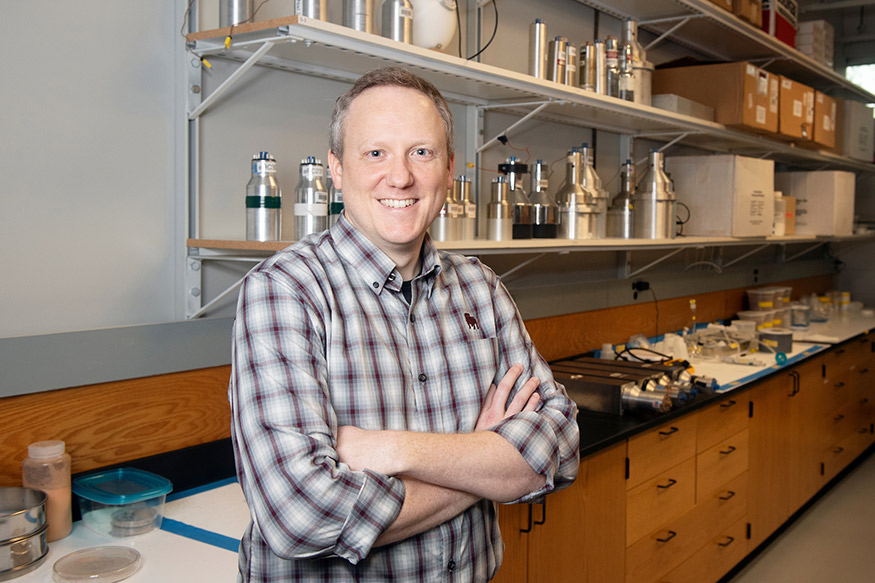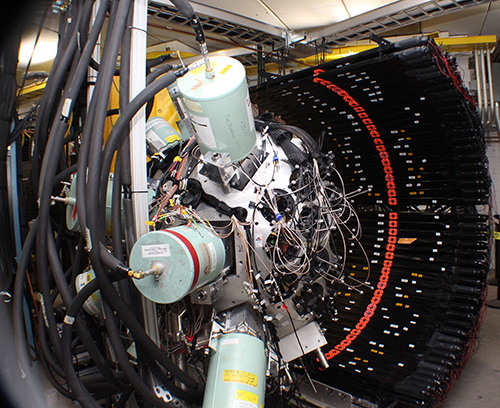MSU physics professor part of multi-institution groundbreaking experiment to ‘push elements to the limit’
MSU Contact: Sarah Nicholas | Berkeley Lab Contact: Lauren Biron

STARKVILLE, Miss.—Benjamin Crider, a Mississippi State associate professor in the Department of Physics and Astronomy, is part of the first—and groundbreaking—experiment at the new Facility for Rare Isotope Beams, measuring how long exotic nuclei can survive at the edge of stability.
The work is published in Physical Review Letters and aims to advance research in areas such as astrophysics and nuclear physics, providing better understanding of how elements form in exploding stars or how processes unfold in nuclear reactors.
Led by the U.S. Department of Energy’s Lawrence Berkeley National Laboratory, Crider and his colleagues—more than 50 participants from 10 universities and national laboratories—have used the one-of-a-kind FRIB to better understand the collection of protons and neutrons found at the heart of atoms, or nuclei. This experimentation on exotic nuclei is allowing experts to refine their best models, those with applications in medical diagnostics and therapies, horticultural and chemical sciences, and oil and gas exploration. The FRIB, which opened in June, is a DOE Office of Science user facility operated by Michigan State University.
“This experiment is aimed at exploring the ways in which a large imbalance of neutrons and protons alters the properties of such so-called exotic nuclei compared to those observed in stable isotopes,” Crider said.
In 2019, Crider received a $680,000 National Science Foundation CAREER Grant—jointly funded by NSF’s Experimental Nuclear Physics Program and the Established Program to Stimulate Competitive Research, known as EPSCoR—to advance his nuclear physics research and gain a better understanding of the atomic nucleus’s structure and work toward a predictive model of the atomic nucleus as a function of proton number, neutron number and energy.
Crider said the FRIB work directly connects with his NSF CAREER grant, a study of the ways in which neutron-rich nuclei can have changes in their shell structure that manifest as deformation in the nuclear shape that can occur alongside one another.
“In my CAREER grant, one of the focal points was studying the nuclear structure of magnesium-32 (32Mg), which is predicted to display many properties indicative of changes to the structure of nuclei farther away from stability—just as those in the FRIB experiment are—though the exact underlying causes may differ from nucleus to nucleus,” said Crider, who previously worked as a postdoctoral research associate at the National Superconducting Cyclotron Laboratory, the forbearer to FRIB.

“The FRIB experiment used the same physics mechanism—beta decay—to populate nuclei of interest for study that the experiments in my CAREER proposal do and, as such, put me on the path to be involved in this work at FRIB,” he said. “In fact, some of the same nuclei in my previous experiment at NSCL were populated in this FRIB experiment. For years, I have been involved in the planning and development of the detection array used in this first FRIB experiment, known as the FRIB Decay Station Initiator, and was the chair of the User’s Executive Committee for the device.”
Heather Crawford, a Berkeley Lab physicist and lead spokesperson for the first FRIB experiment, said, “The breadth of the facility and the programs that are being pursued are really exciting to watch. Our aim is to describe not only these nuclei, but all kinds of nuclei. These models help us fill in the gaps, which helps us more reliably predict things we haven’t been able to measure yet.”
In addition to FRIB, Mississippi State, and the Berkeley Lab, the experiment includes researchers from Argonne, Brookhaven, Lawrence Livermore, Los Alamos and Oak Ridge national laboratories, Florida State and Louisiana State universities, and the University of Tennessee Knoxville.
A native of Mechanicsville, Virginia, Crider holds bachelor’s degrees in physics and mathematics from the University of Richmond, as well as master’s and doctoral degrees in physics from the University of Kentucky.
DOE’s Office of Science is the largest supporter of basic research in the physical sciences in the U.S. and is working to address some of today’s most pressing challenges. For more information, visit www.energy.gov/science.
Part of MSU’s College of Arts and Sciences, the Department of Physics and Astronomy is online at www.physics.msstate.edu.
MSU is Mississippi’s leading university, available online at www.msstate.edu.